Git
Resources:
Commits and branches
A commit in a git repository records a snapshot of all the (tracked) files in your directory. It's like a giant copy and paste, but even better!
commit = snapshot of the project = lightweight safe of project state
Commits can be visually represented as nodes.
- create a commit
git commit -m 'commit message'
Branches = pointer to a specific commit
'branch early, and branch often'
Branches are super lightweight and have no storage/memory overhead
Branches are pointers. To get yourself to a branch you need to checkout there
- create a new branch
git branch new_branch
- go to the branch
git checkout new_branch
- shortcut
git checkout -b new_branch
Merge
Merge = combining work from two different branches together.
Merging in Git creates a special commit that has two unique parents.
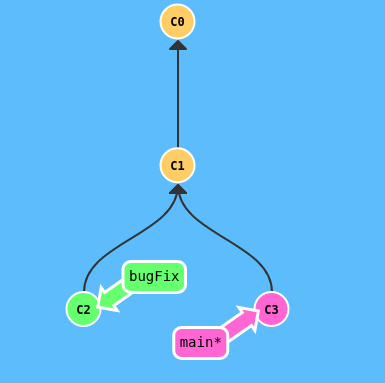

Above we merge bugFix into main and main contains all the work.
- merge
git checkout -b bugFix
git commit -m 'Blah'
git checkout main
git merge bugFix
Rebase
The second way of combining work between branches is rebasing. Rebasing essentially takes a set of commits, "copies" them, and plops them down somewhere else.
Rebasing makes a nice linear sqauce of commits. Commit log of the repo will be cleaner.
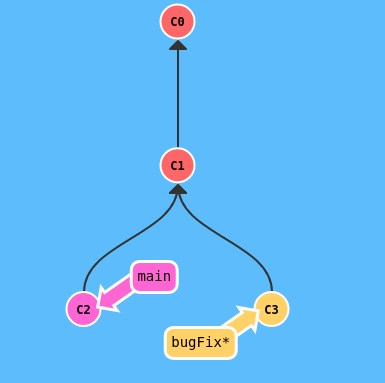
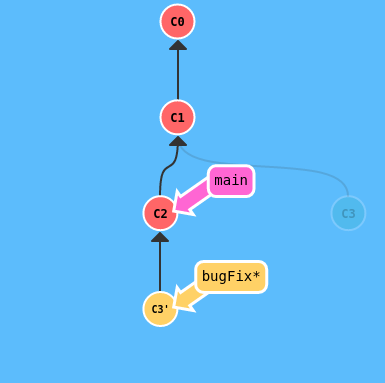
Here we have two branches yet again; note that the bugFix branch is currently selected (note the asterisk)
We would like to move our work from bugFix directly onto the work from main. That way it would look like these two features were developed sequentially, when in reality they were developed in parallel.
C3 still exists, and the rebase creates a copy C3'
- rebase
git checkout -b bugFix
git commit -m 'Blah'
git checkout main
git commit
git checkout bugFix
git rebase main
- interactive rebase (can squash commits)
git rebase -i main
HEAD
HEAD is the symbolic name for the currently checked out commit -- it's essentially what commit you're working on top of.
HEAD is hiding underneath our work on the repo/branches.
HEAD normally point to the branch you are currently working on
Detaching HEAD just means attaching it to a commit instead of a branch.
Example: on main branch with one commit:
HEAD -> main -> C1
git checkout C1 makes HEAD -> C1
To checkout to a commit you need to use its hash (C1)
To see commits hashes:
git log
Moving around git
OPERATORS ^ ~
Specifying commits by their hash isn't the most convenient thing ever, which is why Git has relative refs
saying main^ is equivalent to "the first parent of main
- go to parent commit
git checkout main^
You can also reference HEAD as a relative ref
git checkout HEAD^
- go to previous commit, if current commit is C4, the one below will go to C0
git checkout HEAD~4
Advanced moving when there is a merge
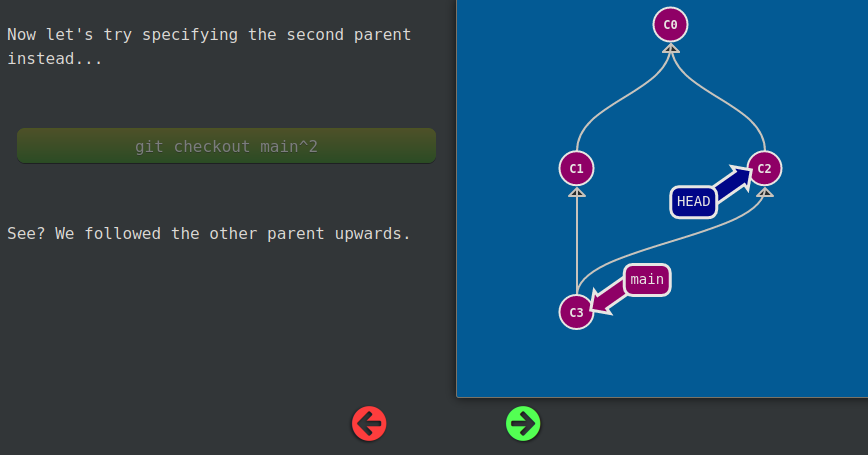
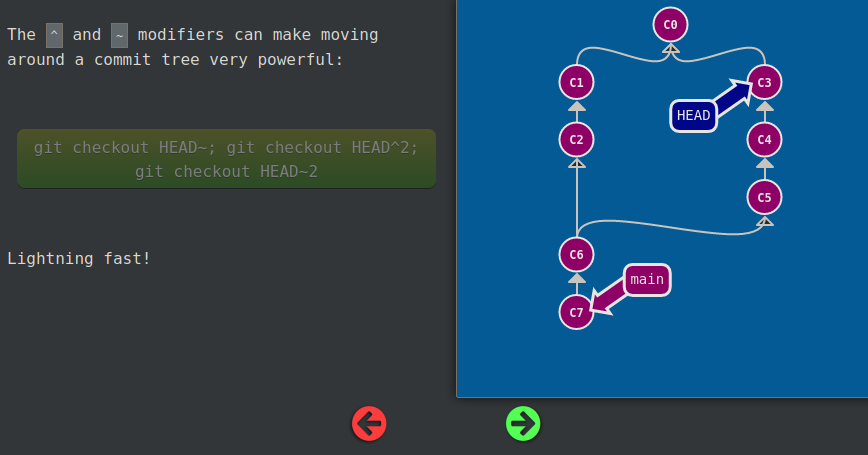
Branch forcing
One of the most common ways I use relative refs is to move branches around. You can directly reassign a branch to a commit with the -f option
git branch -f main HEAD~3
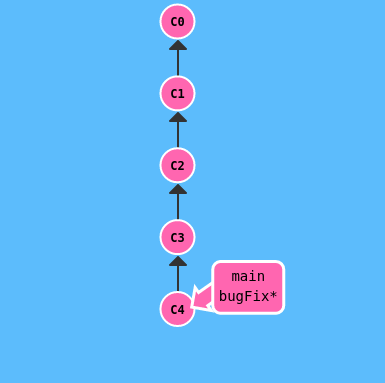
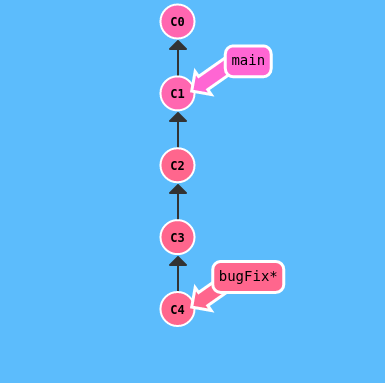
Reversing changes in Git
git reset reverses changes by moving a branch reference backwards in time to an older commit. In this sense you can think of it as "rewriting history;" git resetwill move a branch backwards as if the commit had never been made in the first place.
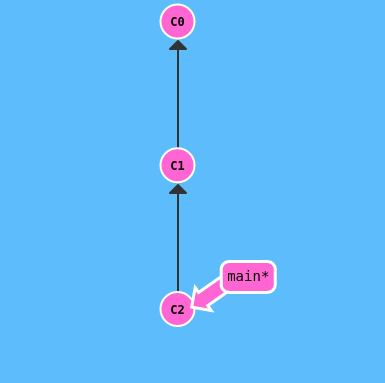
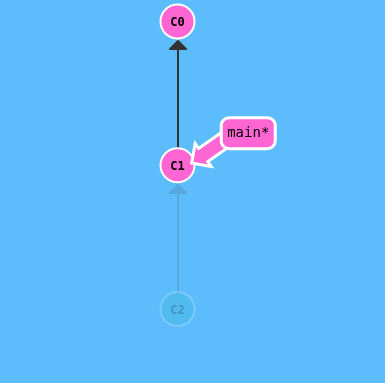
git reset HEAD~1
reset does not work for remote branches. Need to use
git revert HEAD
Moving Work Around
You know how to move around the source tree using reference operators ^ ~.
The next concept we're going to cover is "moving work around" -- in other words, it's a way for developers to say "I want this work here and that work there"
- pick
git cherry-pick <Commit1><Commit2>
says that you would like to copy a series of commits below your current location (HEAD).
- interactive rebase
git rebase -i branch_name
Your current HEAD would copy from branch_name and do a rebase.
In interactive rebase you can reorder, omit, squash, change commit messages.
alternatively using references:
git rebase -i HEAD~3
Juggle commits: Say you want to make changes to an older commit but still keep the order.
Trick: Interactive rebase, then reorder, then make changes, reorder again.
Git Tags
Branches are easily mutated, often temporary, and always changing. You can move them around and refer to different commits. We use tags to permanently mark historical points in your project's history - major releases and big merges.
Tags never move, even if you create new commits.
git tag v1 commit_hash
tags serve as an anchor point:
git checkout v1
git describe
Because tags serve as such great "anchors" in the codebase, git has a command to describe where you are relative to the closest "anchor" (aka tag). And that command is called git describe
git describe <ref>
Where <ref> is anything git can resolve into a commit. If you don't specify a ref, git just uses where you're checked out right now (HEAD).
The output of the command looks like:
<tag>_<numCommits>_g<hash>
Where tag is the closest ancestor tag in history, numCommits is how many commits away that tag is, and <hash> is the hash of the commit being described.
Git Remotes
Git remotes are actually just copies of your repository on another computer. You can typically talk to this other computer through the Internet, which allows you to transfer commits back and forth.
-
remotes serve as a great backup
-
remotes make coding social
-
create local copy of remote repositories
git clone
on your local you iwll have branches: main and origin/main (the remote branch)
Remote branches reflect the state of remote repositories
Remote branches have the special property that when you check them out, you are put into detached HEAD mode. Git does this on purpose because you can't work on these branches directly.
git fetch
git fetch performs two main steps, and two main steps:
- downloads the commits that the remote has but are missing from our local
- updates where our remote branches point
NB: fetch does not update branches
To reflect those changes -- once you have new commits available locally you can do git merge o/main
These two steps are incorporated in
git pull
Collaborative development models
Shared repo model vs Fork and pull model
In a shared repository model, developers work on a single repository. All contributors have write access and crete Pull Requests to merge into main. It is best when you work in smaller teams and private repo.
In fork and pull model, developers for the main repository and can independently work on their fork. They can create branches, merge into the forked main and work independently. If they want to make changes to the upstream repo they will need to create a Pull Request. Only the maintainers of the repo have write access.
Backlinks